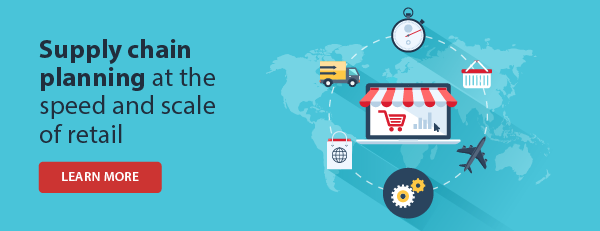It’s an exciting time of the year for retail: holiday season. As price-conscious, busy consumers decide where to buy gifts, groceries and cups of coffee to fuel those marathon shopping trips, it means lots of competition amongst retailers to gain the attention and wallets of those consumers. Customers expect retailers to provide the best products, and they need them to be in stock. They also want a pleasant buying experience, whether in-store or online, so it’s important to keep up with trends and be innovative and responsive to how products reach those customers.
Of course, these challenges exist year-round. And for companies using outdated techniques and technology, it’s nearly impossible to keep up.
Predicting demand for thousands of items across thousands of stores and distribution centers, while incorporating the right data for accurate point-of-sale (POS) forecasts requires a high level of strategic yet agile planning. Plus, the shift towards omni-channel commerce adds complexity to the retail supply chain and often, this complexity is managed in silos and leads to a lack of transparency across the business. And finally, sustainability is only growing more critical to customers, so retailers must find ways to reduce waste from packaging to delivery all while using “greener” ingredients and components.
The urgency to stay on top of these issues never ceases because consumers won’t hesitate to go elsewhere if they can’t get what they want, when they want it, and at prices they can afford in a strained economy.
That’s why it’s critical to keep creating new, more responsive approaches to optimizing your end-to-end supply chain. As Katherine Cullen, Senior Director of Industry and Consumer Insights at National Retail Federation says in this NRF podcast: “We’ve seen, during times of uncertainty and change, that’s when a lot of innovation happens — retailers and consumers and retail employees responding in really incredible ways.”
It might seem easier said than done, right? Here are a few ways to approach your strategy when it comes to retail supply chain excellence.
Respond to change at the speed of retail
In retail, disruptions hit in a real-time manner. “Retail is the industry that’s closest to the consumer, so when something big happens in the world… retail is one of the first places we see the impact,” says Cullen. Whether it’s a delayed delivery or an unexpected spike in demand, timing is everything. Each minute that passes when a retailer does not have product available equals lost sales, and more importantly a potential lost customer due to dissatisfaction.
To respond to these disruptions, it takes more than just adding in a new technology platform to address these issues. Rather, it starts with the people behind supply chains understanding how to best use retail supply chain planning software to their strategic planning advantage. It’s about creating people-centric processes that empower teams to know about issues and disruptions faster so they can connect with one another to respond as quickly as possible.
Achieving a faster, more effective response means silos have to go. With silos, people can’t respond in a timely manner. Things need to happen concurrently. As soon as a disruption hits, everyone across the organization should know and be able to collaborate for a timely resolution.
Manage disruptions at the scale of retail
To be effective, visibility is not enough. Not only should you be able to see issues (visibility), but you must also understand the impact (transparency) of those issues – especially in retail, where you’re dealing with anywhere from hundreds to tens of thousands of stores. The shift to transparency means that planners not only see all the data, they understand exactly how it impacts their supply network.
With transparency, as soon as they find out about the delayed order, they can know instantly which stores will be most affected and which other distribution centers they could source from to offset the delay.
Once there is transparency, you can begin to collaborate with internal and external stakeholders to run multiple scenarios and determine the best decisions. However, this cannot be achieved through multiple spreadsheets and email exchanges –old, disconnected processes will slow down decision-making and cause misalignment.
Modern supply chain management technology enables people across the entire network to communicate and collaborate instantly so they can start moving action plans forward together without the delays of yesterday.
Pivot fast to keep pace with customer demand
Retail continues to go through a big shift towards omni-channel. Customers want the choices and conveniences of buying in-store, buying online with home delivery, or buying online in advance and picking up at a local store. Not only that, but as customers do more of their own research and respond to social media’s signals on trends, demand can shift in a matter of hours or days.
Also, new product launches pose a challenge for retailers because it’s hard to forecast how the market will respond. (Will the new burger launch be a hit, or a flop? Who knew a TikTok influencer would love the new sunglasses you launched – and now you need to race to meet demand?) As these examples become more prevalent, retailers can no longer rely on historical sales alone to predict demand.
They’ll need to incorporate a wider set of internal and external data points to develop agile demand planning and replenishment strategies.
While having advanced analytics and being able to forecast demand with the help of AI and machine learning can be gamechangers for wrangling a massive amount of data, as mentioned above, it’s important that retailers incorporate these types of solutions with their people and processes in mind. People bring context, collaboration, and conscience that AI cannot replicate. AI should augment humans but never replace them, because humans and AI working together is the most powerful combination.
So where do we go from here? As retailers continue to innovate and stay ahead of their competition, it will be key for their supply chains to handle the demands of faster speed, bigger scale, and quickly changing customer preferences. This will lead to supply chain excellence that makes a great impact on the retailer, not only financially, but in a way that best meets the needs of the people working at the company and ultimately, the customers that they serve.






